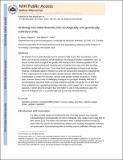| dc.contributor.author | Shapiro, B. Jesse | |
| dc.contributor.author | Polz, Martin F | |
| dc.date.accessioned | 2016-03-11T16:07:15Z | |
| dc.date.available | 2016-03-11T16:07:15Z | |
| dc.date.issued | 2014-05 | |
| dc.identifier.issn | 0966842X | |
| dc.identifier.issn | 1878-4380 | |
| dc.identifier.uri | http://hdl.handle.net/1721.1/101684 | |
| dc.description.abstract | We propose that microbial diversity must be viewed in light of gene flow and selection, which define units of genetic similarity, and of phenotype and ecological function, respectively. We discuss to what extent ecological and genetic units overlap to form cohesive populations in the wild, based on recent evolutionary modeling and on evidence from some of the first microbial populations studied with genomics. These show that if recombination is frequent and selection moderate, ecologically adaptive mutations or genes can spread within populations independently of their original genomic background (gene-specific sweeps). Alternatively, if the effect of recombination is smaller than selection, genome-wide selective sweeps should occur. In both cases, however, distinct units of overlapping ecological and genotypic similarity will form if microgeographic separation, likely involving ecological tradeoffs, induces barriers to gene flow. These predictions are supported by (meta)genomic data, which suggest that a ‘reverse ecology’ approach, in which genomic and gene flow information is used to make predictions about the nature of ecological units, is a powerful approach to ordering microbial diversity. | en_US |
| dc.description.sponsorship | National Science Foundation (U.S.) (Grant DEB 0821391) | en_US |
| dc.description.sponsorship | National Institute of Environmental Health Sciences (Grant P30-ES002109) | en_US |
| dc.description.sponsorship | Gordon and Betty Moore Foundation | en_US |
| dc.description.sponsorship | Broad Institute of MIT and Harvard. Scientific Planning and Allocation of Resources Committee Program | en_US |
| dc.language.iso | en_US | |
| dc.publisher | Elsevier | en_US |
| dc.relation.isversionof | http://dx.doi.org/10.1016/j.tim.2014.02.006 | en_US |
| dc.rights | Creative Commons Attribution-NonCommercial-NoDerivs License | en_US |
| dc.rights.uri | http://creativecommons.org/licenses/by-nc-nd/4.0/ | en_US |
| dc.source | Elsevier | en_US |
| dc.title | Ordering microbial diversity into ecologically and genetically cohesive units | en_US |
| dc.type | Article | en_US |
| dc.identifier.citation | Shapiro, B. Jesse, and Martin F. Polz. “Ordering Microbial Diversity into Ecologically and Genetically Cohesive Units.” Trends in Microbiology 22, no. 5 (May 2014): 235–247. | en_US |
| dc.contributor.department | Massachusetts Institute of Technology. Department of Civil and Environmental Engineering | en_US |
| dc.contributor.department | Parsons Laboratory for Environmental Science and Engineering (Massachusetts Institute of Technology) | en_US |
| dc.contributor.mitauthor | Polz, Martin F. | en_US |
| dc.relation.journal | Trends in Microbiology | en_US |
| dc.eprint.version | Author's final manuscript | en_US |
| dc.type.uri | http://purl.org/eprint/type/JournalArticle | en_US |
| eprint.status | http://purl.org/eprint/status/PeerReviewed | en_US |
| dspace.orderedauthors | Shapiro, B. Jesse; Polz, Martin F. | en_US |
| dc.identifier.orcid | https://orcid.org/0000-0001-9296-3733 | |
| mit.license | PUBLISHER_CC | en_US |
